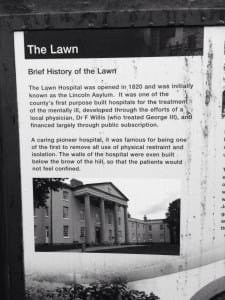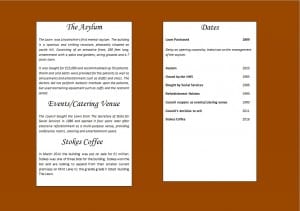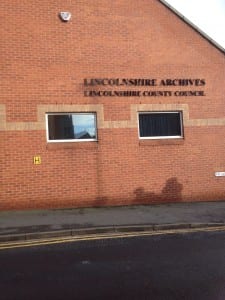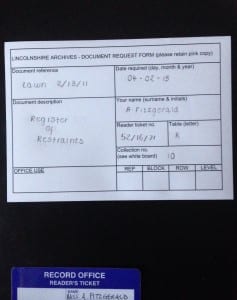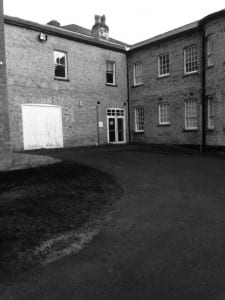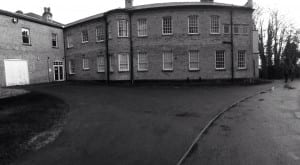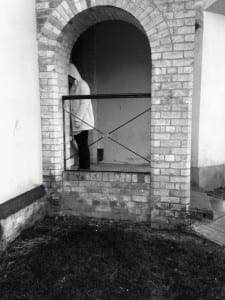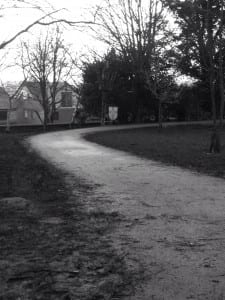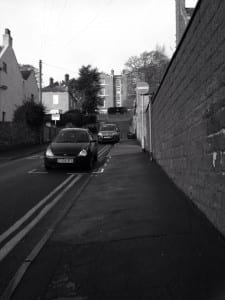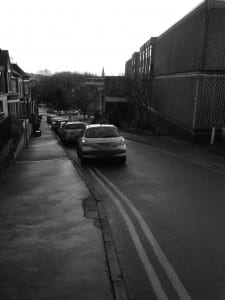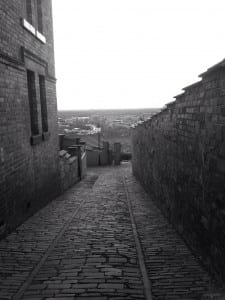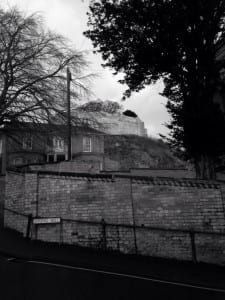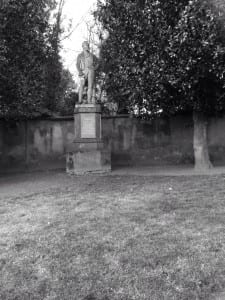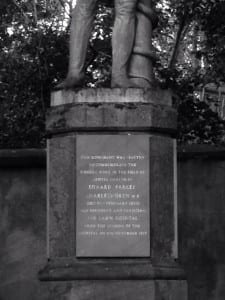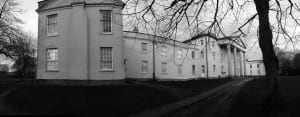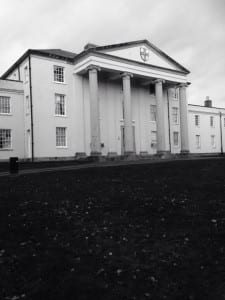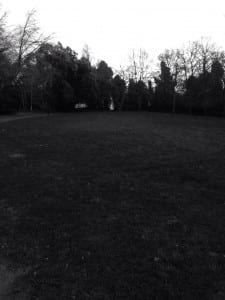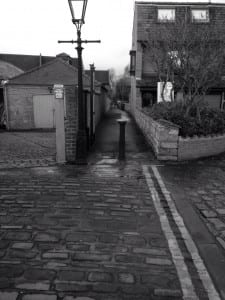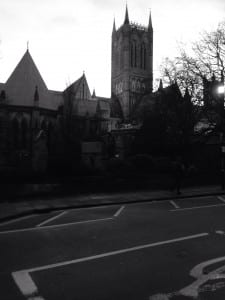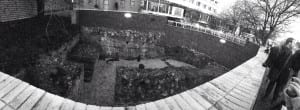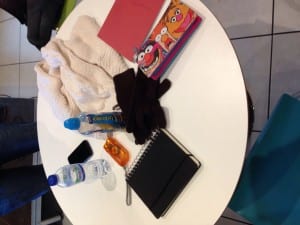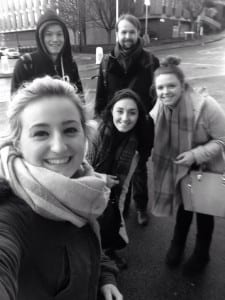Framing Statement
For our Site- Specific performance module our overall task was to create an audio influenced piece. The term site specific is described by Mike Pearson as ‘a staging and performance conceived on the basis of a place in the real world…A large part of the work has to do with researching a place, often an unusual one that is imbued with history or permeated with atmosphere.’ (Pearson, 2010, 7) By firstly going on a drift through the city of Lincoln, ‘a detour, a diversion from the functional journey’ (Smith, 2010,199), it allowed us to visit parts of the area which we had not yet seen or discovered. To begin with, walking up the hill in the snow was not very appealing to us, but the further away we got from familiarity, the more we began to appreciate our surroundings.
It was during this drift that we first discovered The Lawn, a site which immediately appealed to us all. This was to become a symbol of our final site. Visually, The Lawn was pleasing; a large orange building which overlooked a spacious area of green grass. However, there was also an element of eeriness to the place. Apart from the subtle sounds of nature, it was a very quiet area. Tall trees followed the perimeter of the space, almost acting as a barrier, enclosing us from the rest of the city. After some time, we then discovered by reading a sign nearby (as seen in figure 1) that the building had a lot of historical background. ‘…Initially known as the Lincoln Asylum. It was one of the countries first purpose built hospitals for the treatment of the mentally ill.’ It was this information which sparked our decision to further our knowledge and we were soon to create a piece based on the development of the site which we called The Madness behind Coffee.
Initially we saw The Lawn’s grounds as a great opportunity for performance space, but due to building restrictions, we decided to change the location of our site to Stokes Coffee shop whilst still having The Lawn as a main basis for the piece. ‘The Madness behind Coffee’ was a fifteen minutes long performance shown to one audience member at a time. Much like the company Punchdrunk, our performance ‘focus was as much on the audience and the performance space as on the performers and narrative.’ (Punchdrunk, 2015.) We wanted to make sure that each audience felt comfortable. Outside the coffee shop each person coming to view the performance was greeted at the door by Sam and I, who then bought them a hot drink of their choice. We then lead them upstairs and sat them in a particular seat by the window before proceeding to give them what looked like a Stokes coffee menu, created by us. Laid out in a similar formatting style to a menu, it acted as a programme for our piece. We included images of The Lawn, along with key dates and information from the 1820’s until now. We hoped for this menu to enlighten the audience member on the development of the site, so that they understood the audio aspect of our performance. Our audio was built from snippets of different character perspectives through the decades. This began with Dr Edward Parker Charlesworth, the founder of the Lawn, then followed by a nurse, patient, council worker and then finally a Stokes representative. Whilst each character was heard through the headphones, we each made ourselves visible, whether this was by sitting opposite the audience member, or by standing outside where we could be seen by the audience member once instructed to look out the window. Although much of the script was influenced by factual information, there were some elements of fiction. Govan touches on the point that ‘…performers will blend fact and fiction and will shape the real material that they find in order to develop the creative project.’ (Govan, 2007, 131) We equally found that there had to be a certain element of fiction to our piece when creating the script. Particularly when creating characters based on real people, although we had a vague idea on each individual’s different views, we could not be certain that some of what we expanded on was entirely accurate.
Analysis of Process
Although the internet was a starting point for us when researching the past, a trip to the Lincolnshire Archive we found to be more beneficial. It provided us with factual information from original documents such as physician journals, a register of patients who attended The Lawn, and a register of restraints which were used on the patients. This information was valuable to us because we were able to start to build a true picture on how The Lawn operated. Beginning the module in January meant that we had a limited amount of time to gather our research. Yi-Fu Tuan’s acknowledges the importance of time spent in a place, ‘how long does it take to get to know a place?’ (Tuan, 1977), In relation to this expression, I feel that the archive definitely decreased the time it took for us to get to know the Lawn. When we first found out that it was an asylum, we presumed it to be a place filled with horror, but with further investigation this was not the case at all. Patients were admitted to this particular asylum for mental illnesses where they were treated with care and consideration. A document in the archive stated that ‘Entertainment for the patients was an important part of their treatment, and provision was made.’ It was this discovery that informed us with a lot of information to create the basis of our script.
Before proceeding to create audio based on our findings of The Lawn’s past from information we had gathered from both the internet and the archive, we decided to firstly contact the council to check if we were able to use the site. It was then that we came across our first obstacle where we were informed that they no longer owned the premises and that a local coffee company called Stokes had taken it over. We got in touch with a man named Nick Peel, the manager of Stokes, who then told us that the refurbishment was due to begin in May but we were still welcome to use the site if we wished. As Govan states, ‘contemporary public spaces present particular problems to the performance maker’ (Govan, 2007, 131) Collectively we discussed that there could be some disadvantages of using the site. Depending on what sort of building work was planned for May, it could have restricted the clarity of the audio we were yet to record. It was then that we had an important decision to make. As we had collected so much research which was of value to us, we did not want to start over, so we decided to expand on the research we had already gathered and not just create a piece based on the history of The Lawn, but also cover future plans for the site. Stokes Coffee company were in the process of turning The Lawn in to ‘a microroastery but on a bigger scale’ (Whitelam, 2014), so changing location to Stokes Coffee shop related to our new concept giving the audience a glimpse of what was to come, whilst also enabling our research gathered from the archive to still be of use to us.
Finding current information on The Lawn was mainly done by using the internet where we able to access online newspaper articles. This provided us with direct quotes, which we then expanded on to create the basis of our script for the Council Worker and Stokes Representative.
Once the script had been finalised we could then begin the recording process. As it was the main part of our performance, we took various attempts to ensure that each recording was of a high quality. With each recording there were many factors to consider, the clarity of speech from the actor and the tone of voice used, along with the volume of the recording – if it was too loud or too quiet, the ambience – what might be heard in the background, and a consideration of what wild track might be used along with speech, to build a realistic atmosphere.
Reflecting on the recording of the news reporter and council workers script which involved myself and Alex, it took a number of attempts to get it to a good performance standard. One of the problems which we had was trying to make it sound realistic. We had attempted to record outside but discovered that the sound of the wind was far too harsh and distorted parts of our speech. To resolve this problem, we decided to record in a corridor. We had spent a previous lesson finding the most appropriate spaces to record and figured that this place sounded best, whereas other areas such as the studio, had a slight echo. We then had to layer the recording of us, with a track which we found on the internet which was of high street noises. We did attempt to record this ourselves, but again the wind was a problem, so we found the recording on the internet to be a higher quality with less disruptions.
To help the flow of recordings from past to present, we used music. Kaye and Lebrecht emphasise the view that ‘Transitional sounds or music represent a movement of the action through time or place. (Kaye and Lebrecht, 2009, 23) In a particular part of our script, we had quite a large movement through time, from Ellie’s character of a patient from the Asylum, to the modern day character which I played of a council worker. There was a noticeable contrast between the two characters, the patient was delicately spoken whereas as the council worker, I had a more abrupt tone to my voice. The music which played for a while, before fading out, enabled a smooth transition between these two characters whilst also helping improve the structure of our audio.
When we were rehearsing we noticed that we needed more visual representations of The Lawn and a more detailed account of information about the site and how it had changed over the years. We could not rely on the audio alone to provide the audience with enough information to be able to understand our concept and we also did not want to put some of our research to waste. Originally we had the idea to create mood boards. We produced two A1 sized boards, one for the past of the Lawn, and one for the present. The one reflecting the past contained leaves which we had collected from the site along with a quote which we had found on the internet extremely relevant to our concept, ‘“Abandoned buildings are not a benefit to anyone. I think the Strip can comeback to life without necessarily being what it was before” (Terry, 2015.) The other board contained more modern day photographs relating to what The Lawn was from when it was bought by the social services in 1986, onwards. Although we really liked how the collages looked, when discussing them with our lecturer, Karen, she questioned why there would be such large constructions in a coffee shop. Once we had time to think about it, we decided to take on board the advice that we were given and leave the mood boards behind. We also realised that as they were only collages, the audience therefore were still not being provided with facts.
Our second idea of a visual representation was a newspaper. We believed by creating this form of document, unlike the mood board, it would inform the audience of the facts. Another positive would be that it would blend in amongst the site. Newspapers and books are recognisable features found in coffee shops, so it would not look peculiar to have on the table. After creating these newspaper articles, we then tested our performance on an audience member, to see how it worked. The feedback we received made us again change our mind. Was an audience member really going to sit there and read an abundance of text? It would have also taken up a lot of time for them to read each article.
Finally we had the idea to create what looked like a Stokes coffee menu visually by the colours and layout, but inside, would be a programme for our piece. We replaced where the different drinks and prices would normally be with short descriptions of what the lawn was in particular time periods. For instance, where it was listed ‘Liquor coffee £4.00’ (Stokes, 2015) we replaced this with ‘Council reopens as events/catering venue 1990.’ Below, in figure 2, you can see an example of a page in the menu that we made.
The final stages of rehearsal were ensuring that we entered and exited the space with the correct timings in sync with what was heard by the audience through the audio. Whilst doing this, we also had to work on performance techniques. In order to stop distraction from the audio, we decided to limit each character to just one interaction with the audience member. The doctor played by Alex, handed our participant a copy of the exact letter which we found in the archive that would have been given to a person thought of as mental. Lauren, who played the nurse, reached for the participants arm to check a pulse in correlation with what was being said in her recording. Playing the patient, Ellie, sat up a chess board to reflect that this was used as part of their treatment. The audience member could then interact if they wanted to. She then proceeded to stare out of the window, to shift the audience’s attention to myself and Alex who could be seen having an interview outside. Finally Sam entered the space, shaking hands with the participant as though he was greeting customers in his newly opened establishment. Along with interaction establishing that we were the characters heard through the audio, costume also made this clear. We all wore costumes similar to what our characters would have wore. Rehearsing with performance techniques whilst being in costume was an important aspect of transforming our performance from rehearsal standard, to performance standard.
Performance Evaluation
On the 7th May 2015 The Madness behind Coffee was performed in Stokes Coffee shop to an overall total of four people. Reflecting upon our performance as a group, I was pleased with the outcome, however like in all performances, I believe there was still room for improvement if we had been given more time for the module.
Overall I think that the decision to stick with the concept of The Lawn, but change the site to Stokes Coffee proved to be really interesting. I liked the element of curiosity which the audience received upon arrival, wondering why we had taken them in to a coffee shop for a performance, but I hope that this became clear to them at the end of the piece. Although I loved that the participant got to experience a indication of what was to come from the Lawn indulging the atmosphere of a 16th century style coffee shop, there were some restrictions of using such a public space. For instance, there was a moment in the performance when workers of the coffee shop began to loudly enter the space and stack boxes in the space. Although we did anticipate that outsiders would be in view with it being a piece performed in a public space, we did find it quite unfortunate that this particular scenario could perhaps break the connection between the actor and audience. We expected customers of the coffee shop may be drinking in the space which we thought would help build a casual atmosphere but did not want too many vocal distractions.
To improve the connection between the audience and performer I may have added in more interaction with the audience members. Although we did not want to distract too much from the audio, when receiving feedback each audience member said that they would have liked to have seen more of this. I believe it would help make the performance more enjoyable and also would have helped participants to feel more comfortable and relaxed if they were involved more in the piece.
A noticeable downfall in our script think was lack of characters which we included between the time period of 1985 when The Lawn was closed by the NHS, until now. There was a very large time shift from the character of the patient who attended the asylum, to the council member from the year 2014. In my opinion in this gap there was potential for other characters to have been included. For example by adding a representative from the social services, a wedding planner and a caterer it would have ensured that we covered all key points in history from The Lawn, in correlation to the historical points referenced in our menu. I think the reason we did not do this was because we wanted to keep the piece as factual as possible, and on the internet there was not much information regarding this time period.
Generally I was really happy with how we worked in a group. We all had an even contribution to the piece and were very dedicated in to putting time in to the piece which helped the process run smoothly. The module I found to be intriguing, certainly not like anything that I have done in the past, however it has given me a new light to performance. I have realised that public spaces can be very symbolic in terms of meaning and unique material can be created.
Bibliography
Govan, E. (2007) Making Performance: Devising Histories and Contemporary Performance. Oxon: Routledge.
Kaye, D. and Lebrecht, J. (2009) Sound and Music for the Theatre. 3. Oxford: Elsevier Inc.
Pearson, M. (2010) Site Specific Performance. Basingstoke: Palgrave Macmillian.
Punchdrunk (2015) Company Stucture. [online] Available from http://punchdrunk.com/#company/column/2 [Accessed 26th January 2015]
Smith, P. (2010) Mythogeography A Guide to Walking Sideways. Devon: Triarchy Press.
Stokes (2015) Main Café Menu. [online] Lincolnshire: Stokes. Available from http://stokes-coffee.co.uk/wp-content/uploads/2014/12/Stoke-Cafe-Menu-F-2014.pdf [Accessed on 19th April 2015]
Terry, D. (2015) Dan Terry Quotes. [online] Dan Terry. Available from http://thinkexist.com/quotes/dan_terry/ [Accessed 19th March 2015].
Tuan, Y. (1977) Space and Place. Minneapolis: The Regents of the University of Minnesota.
Whitelam, P. (2014) Stokes Coffee is to take on The Lawn. Lincolnshire Echo, 28 November, 1. Available from http://www.lincolnshireecho.co.uk/Stokes-Coffee-Lawn/story-24829935-detail/story.html [Accessed 9th March 2015].
